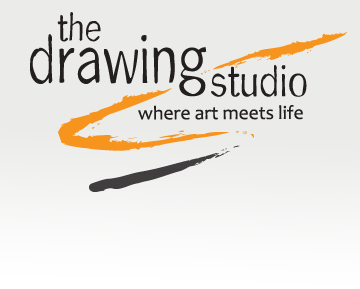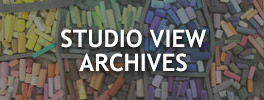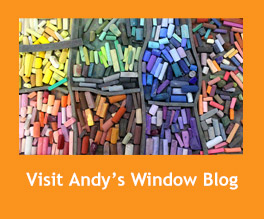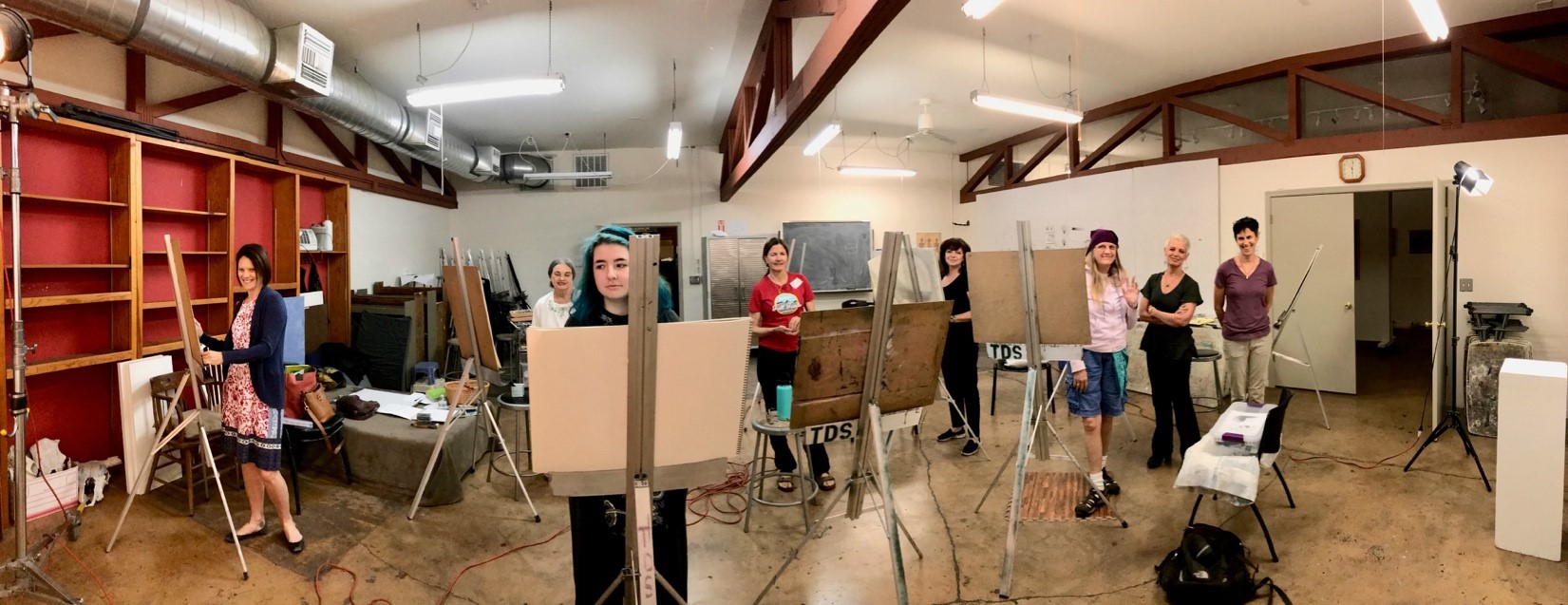
Learning to See in New Ways
By: Deborah Daun
When I decided to take the Drawing Studio’s Drawing Fundamentals 1 course recently, I was delighted to find that many of my classmates were attracted to the course for introspective reasons, as I was. During introductions, things they said included: I want to get out of my head. I hope it will calm me. Doing art is soul searching and peaceful. Everything falls away and my troubles are gone when I draw.
I had heard that learning to draw wasn’t so much about drawing, but about learning to see in new ways. That appealed to me.
But first there were skills to learn, attention to cultivate, resistance to overcome, and the tools of the trade to figure out. Who knew that there are at least three kinds of erasers that do more than wipe the slate clean; a quick, short sweep of a charcoal eraser also lightens a dark swatch, allowing, for example, the petals of a lighter flower to emerge from a dark background. And then there is the physical skill of drawing with your hand, adding some elbow grease and eventually engaging the shoulder.
It’s reminiscent of an approach to teaching yoga that I learned years ago. First, you teach your students the basics of breathing and moving correctly so that they don’t hurt themselves. Then you show them how to stay with a pose and hang out with whatever arises, including wandering minds and resistance. You then create a space through modeling and language that allows students to move into a flow that facilitates experiencing oneself in new ways.
Shape and Measurement
We started with the concept of shape and, of course, I started to play with the word. The shape of things to come. Ship shape condition. You better shape up, which, I realized I had to do when I misunderstood the first homework assignment: draw just the outline of a simple object. I’d drawn a lot of interior detail, perhaps because I wanted to explore something our instructor Nancy had us do when we arrived for the first of six classes.
Draw what you remember, she had suggested. A cat, truck, cactus, telephone, lamp. I drew my favorite lamp from memory and then went home and practiced drawing what I actually saw. It made me think of my brother, a police lieutenant, who once told me that first-hand accounts from witnesses are not often very accurate. They tell you what they remember, not necessarily what they actually saw on that cold and windy day.
Back to shape. When I understood the concept, I began to notice just the shape of everyday things around me. I stopped in the alley behind my house while walking the dogs and stared at the particularly interesting shape of an outdoor heater that was visible above the neighbor’s fence. It was beautifully spherical with a glow from the morning sun.
I began to understand that my eyes take in the world in two dimensions and my brain adds a third. I have to extract my brain and focus just on what I see (not on what I think I see) to draw a shape.
On to measurement, a concept Nancy introduced by employing the type of wooden sticks used to skewer meat and vegetables for kebabs. Hold the stick, extend your arm and measure the object you are about to draw. Compare the height to the width at the widest point. Close one eye and then the other to get a more two-dimensional view. Keep your arm extended the same distance from your body when comparing. A lot to think about and, like anything, mastery takes repetition.
Measurement helped me better understand the concept of shape. I drew the outline of a painted water pitcher from my kitchen that is higher that it is wide. Or so I thought.  When I held my stick out in front of me and compared the height to the width, they were the same. As it turns out, the thin handle makes the pitcher as vertical as it is horizontal.
When I held my stick out in front of me and compared the height to the width, they were the same. As it turns out, the thin handle makes the pitcher as vertical as it is horizontal.
Tone
Nancy compared shape and measurement to individual planets. By comparison, the concept of tone catapulted us into the entire universe—a big conceptual leap to say the least. Tone, also called value, is all about light.
We began by drawing value scales. I started with five small connected boxes, drew the middle tone in box 3, the darkest in box 5, the lightest in box 1, and then the others. I did the same thing with 7 boxes and then 9 boxes, with the lightest to darkest tones becoming increasingly nuanced. I learned that you can see lines between things without actually drawing a line.
A floral arrangement was our tonal study during class. OK… where in the universe do I start? Nancy had some ideas. Turn on some music. Look deeper at the tones. Lightly  sketch an outline. Fill it in as you go. Take your time. Consider adding dark tones and then using an eraser to create lighter tones.
sketch an outline. Fill it in as you go. Take your time. Consider adding dark tones and then using an eraser to create lighter tones.
At the close of class, I was struck by how different each classmate interpreted the vase filled with flowers. Some had a wide range of tones. Others, like mine, were on the lighter side. Some were three-dimensional and others just two. Some were quite fanciful, others akin to photographs.
Our homework was another tonal study: draw a cup, vase, pitcher or other cylindrical object with a shiny, smooth surface. Nancy said to “add a little water if you want and push in the direction of darks, but don’t lose the highlights. Include cast shadows, shadows on the object and variances within those shadows and tones, reflections and highlights. Consider point of view and composition.”
I opted for a large, cylindrical vase with water in it, sitting on top of a small round table. My drawing ended up looking like Abraham Lincoln’s top hat, according to my husband. We had a really good laugh and I explained to him that perfection is not my 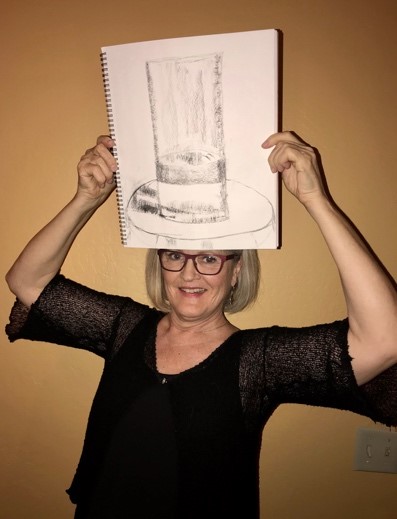 goal. It is a process and the top hat is just one stop on my road to learning to see in new ways via this medium called drawing.
goal. It is a process and the top hat is just one stop on my road to learning to see in new ways via this medium called drawing.
Perspective
Perspective is also called depth. As we wrapped our minds around how to show three-dimensional space on the flat surface of our sketchbooks, Nancy’s suggestions included: make the closer object larger and the one further away smaller; and make the foreground sharp and the background fuzzy. We learned terms like foreshortened and vanishing point. The former refers to drawing long objects when viewing them head on, the latter is the point where all lines merge on or off the paper.
We stacked bricks at different angles during class, then looked at and drew them from different sides. Homework that week was to draw a chair. The differences in each of my classmates’ drawings were intriguing, as were their comments about one another’s work: I can feel the velvet seat in the chair you drew. I can tell you were inspired by your subject. I can sense your emotional response in this drawing; is the chair a family heirloom?
For our last in-class project, Nancy arranged big, white boxes of varying sizes with large rolls of paper at odd angles in the mix. She placed a random assortment of items on this 4-foot structure: a cloth fish, a metal pitcher, a dotted chicken and a rhinoceros made from papier mache.
We then picked the angle we liked, decided how much of the odd, towering collection to draw, and went to work.
 It was our sixth and final class, and it was Halloween night. Drawing was interspersed with cookies and candy, and at one point, plastic cups of champagne brought in by a classmate to toast her beloved mother–an artist named June–who had passed away quite suddenly during our 6-week course. June’s creativity and tenacity at pursing her art was what inspired her daughter to take Drawing Fundamentals 1. Here’s to June, to taking the time to really look at the world around us, and to the Drawing Studio for teaching us how to see it in new ways.
It was our sixth and final class, and it was Halloween night. Drawing was interspersed with cookies and candy, and at one point, plastic cups of champagne brought in by a classmate to toast her beloved mother–an artist named June–who had passed away quite suddenly during our 6-week course. June’s creativity and tenacity at pursing her art was what inspired her daughter to take Drawing Fundamentals 1. Here’s to June, to taking the time to really look at the world around us, and to the Drawing Studio for teaching us how to see it in new ways.
Deborah Daun is a Marketing/PR pro with passion for supporting mission-driven organizations with heart-opening and data-driven strategies and stories. She’s never taken an art class before this Drawing Studio course, but when she interviewed founder Andy Rush a few years ago, her curiosity was piqued when he told her that learning to draw was really about learning to see in new ways. You can follow Deborah on Twitter at @AZphilanthropy
